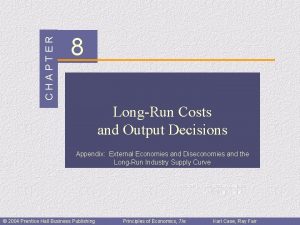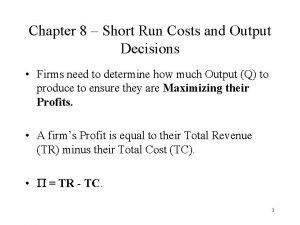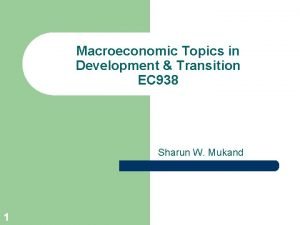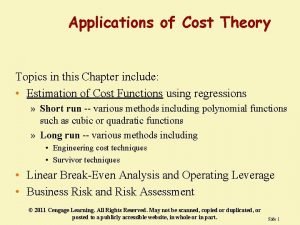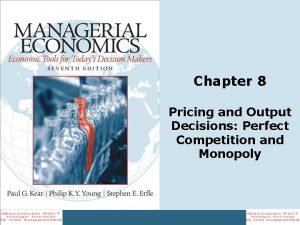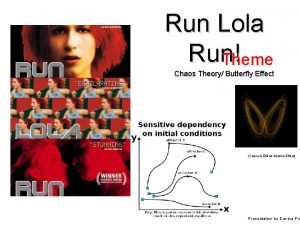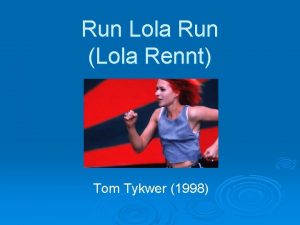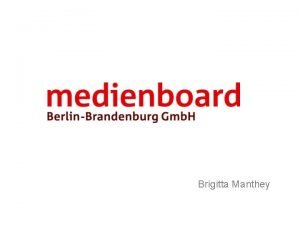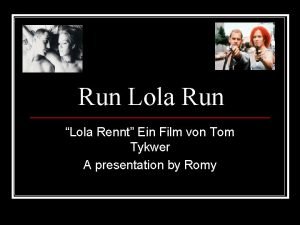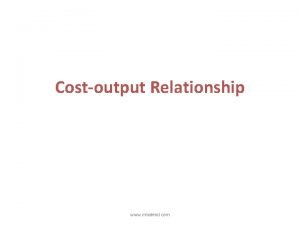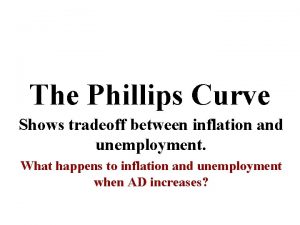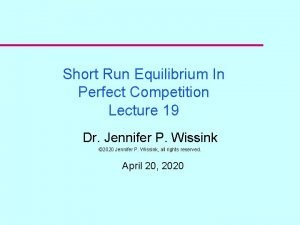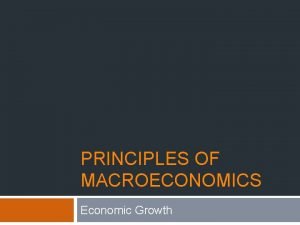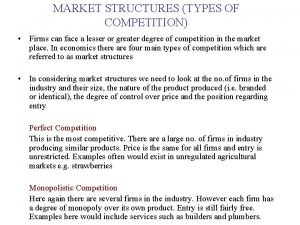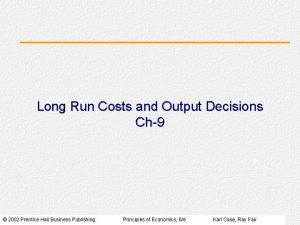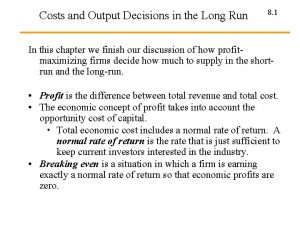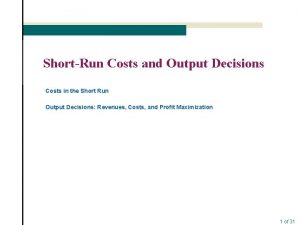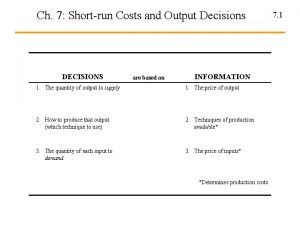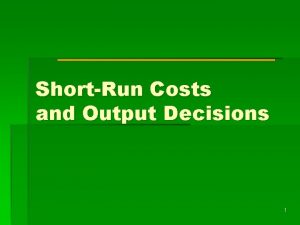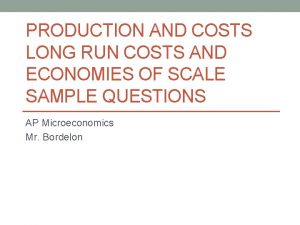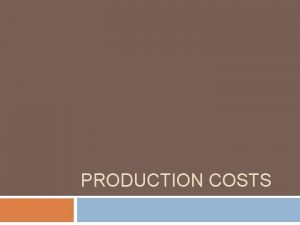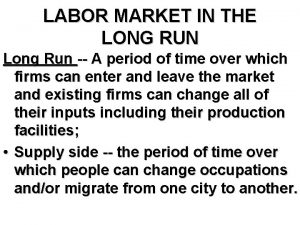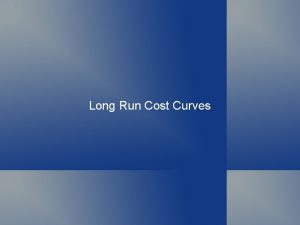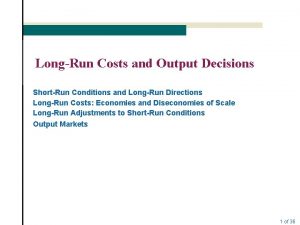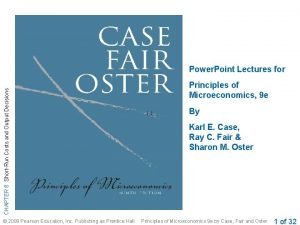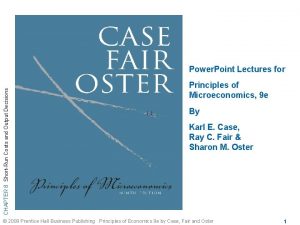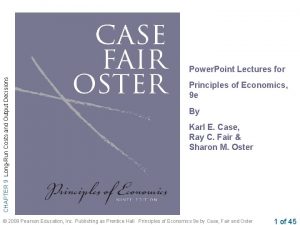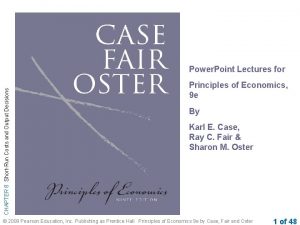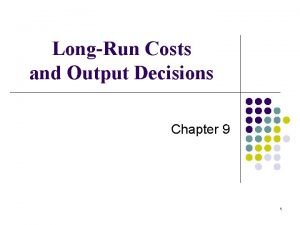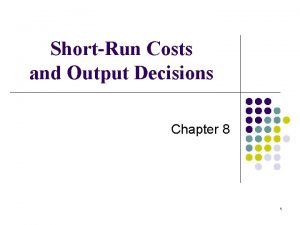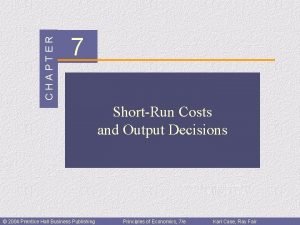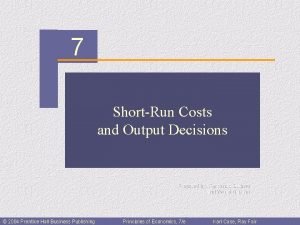Costs and Output Decisions in the Long Run























- Slides: 23

Costs and Output Decisions in the Long Run 8. 1 In this chapter we finish our discussion of how profitmaximizing firms decide how much to supply in the shortrun and the long-run. • Profit is the difference between total revenue and total cost. • The economic concept of profit takes into account the opportunity cost of capital. • Total economic cost includes a normal rate of return. A normal rate of return is the rate that is just sufficient to keep current investors interested in the industry. • Breaking even is a situation in which a firm is earning exactly a normal rate of return so that economic profits are zero.

Firm Earning Positive Profits in the Short Run • To maximize profit, the firm sets the level of output where marginal revenue equals marginal cost. 8. 2

Firm Earning Positive Profits in the Short Run: Example from Ch. 7 Widget Market S 8. 3 Widget Firm MC ATC $70 d P=$70 ATC=$46. 67 AVC D Algebra: q*=6 Profits Total costs

Minimizing Losses • Operating profit (or loss) or net operating revenue equals total revenue minus total variable cost (TR – TVC). • If revenues exceed variable costs, operating profit is positive and can be used to offset fixed costs and reduce losses, and it will pay the firm to keep operating. • If revenues are smaller than variable costs, the firm suffers operating losses that push total losses above fixed costs. In this case, the firm can minimize its losses by shutting down. 8. 4

8. 5 Minimizing Losses Suppose the market price of widgets falls to $30. The firm finds its new profit-maximizing output level where P=MC. This occurs at q*=4. However, the firm earns a negative economic profit. Widget Market Widget Firm S MC ATC=$40 $30 AVC P=$30 d D Algebra: q* = 4 Losses (negative profit)

Minimizing Losses and the Shut-down Point 8. 6 How low can price fall until the firm would be better off shutting down (q* = 0)? Remember that in the short-run, if the firm produces nothing, its revenues are zero but its costs equal TFC profits = -$TFC As long as price is sufficient to cover average variable costs (P > AVC), the firm stands to gain by operating instead of shutting down. Shutdown point: a market price that, when it intersects MC, it also equals AVC. This will occur only at the minimum point on the AVC curve. (See chapter 7)

Short-Run Supply Curve of a Perfectly Competitive Firm 8. 7 The short-run supply curve of a competitive firm is the part of its marginal cost curve that lies above its average variable cost curve. This explains why supply curves are upward sloping: because MC is upward sloping…and why is MC upward sloping?

The Short-Run Industry Supply Curve 8. 8 • The industry supply curve in the short-run is the horizontal sum of the marginal cost curves (above AVC) of all the firms in an industry.

Profits, Losses, and Perfectly Competitive Firm Decisions in the Long and Short Run SHORT-RUN CONDITION Profits Losses TR > TC 1. With “operating” profit (TC TR TVC) 2. With operating losses (TVC >TR) SHORT-RUN DECISION 8. 9 LONG-RUN DECISION Operate where P=MC Expansion new firms enter Operate where P=MC Contract: firms exit (losses < fixed costs) Shut down: b/c at P=MC Contract: firms exit losses = fixed costs • In the short-run, firms have to decide how much to produce in the current scale of plant. • In the long-run, firms have to choose among many potential scales of plant.

Long-Run Costs: Economies and Diseconomies of Scale 8. 10 The long-run is a time period during which all inputs are variable (including the scale of production) and firms can enter and exit the industry. We want to analyze how average total cost changes as output changes: 1) Increasing returns to scale, or economies of scale, refers to an increase in a firm’s scale of production, which leads to lower average total costs per unit produced.

Long-Run Costs: Economies and Diseconomies of Scale (con’t) 8. 11 2) Constant returns to scale refers to an increase in a firm’s scale of production, which has no effect on average total costs per unit produced. 3) Decreasing returns to scale refers to an increase in a firm’s scale of production, which leads to higher average total costs per unit produced.

The Long-Run Average Cost Curve 8. 12 The long-run average cost curve (LRAC) is a graph that shows the different scales on which a firm can choose to operate in the long-run. Each scale of operation defines a different short-run. Here is a diagram of a long run average cost curve of a firm exhibiting economies of scale. It is downward-sloping:

Weekly Costs Showing Economies of Scale in Egg Production JONES FARM 15 hours of labor (implicit value $8 per hour) Feed, other variable costs Transport costs Land capital costs attributable to egg production Total output Average cost CHICKEN LITTLE EGG FARMS INC. Labor Feed, other variable costs Transport costs Land capital costs Total output Average cost 8. 13 TOTAL WEEKLY COSTS $120 25 15 17 $177 2, 400 eggs TOTAL WEEKLY COSTS $ 5, 128 4, 115 2, 431 19, 230 $30, 904 1, 600, 000 eggs

A Firm Exhibiting Economies and Diseconomies of Scale 8. 14 • The long-run average cost curve of a firm that eventually exhibits diseconomies of scale becomes upward-sloping.

About the Long-Run Average Cost Curve 8. 15 LRAC shows the lowest average cost for producing each level of output LRAC is tangent to every SRATC but not necessarily at the Min SRATC points. As we trace production along a SRATC, the firm is altering its production in the presence of a fixed factor (fixed scale of production). SRATC increases because of the fixed factor. As we trace production along the LRAC, the firm is altering the optimal plant size as q changes.

Optimal Scale of Plant • The optimal scale of plant is the scale that minimizes average cost. 8. 16

Long-Run Adjustments to Short-Run Conditions 8. 17 • Firms expand in the long-run when increasing returns to scale are available. • Prices will be driven down to the minimum point on the LRAC curve.

The Path to Long-Run Equilibrium 8. 18 Suppose the current short-run has firms earning positive profits • This will attract new entrants to an industry. • As capital flows into the industry, the supply curve shifts to the right, and price falls. • Firms will continue to expand as long as there are economies of scale to be realized, and new firms will continue to enter as long as positive profits are being earned. When does it settle down (reach “equilibrium”)?

The Path to Long-Run Equilibrium 8. 19 Suppose the current short-run has firms earning losses (negative profits) • There is an incentive for some firms to exit the industry. • As firms exit, the supply curve shifts left, driving price up. • This gradual price rise reduces losses for firms remaining in the industry until those losses are ultimately eliminated. When does it settle down (reach “equilibrium”)?

Long-Run Adjustments to Short-Run Conditions • As firms exit, the supply curve shifts from S to S’, driving price up to P*. 8. 20

Long-Run Equilibrium • The industry eventually returns to long-run equilibrium and losses are eliminated. 8. 21

Long-Run Equilibrium in Perfectly Competitive Output Markets 8. 22 • Whether we begin with an industry in which firms are earning profits or suffering losses, the final long-run competitive equilibrium condition is the same. • In the long-run, equilibrium price (P*) is equal to long-run average cost, short-run marginal cost, and short-run average cost. Profits are driven to zero. The “four-way intersection” P* = MC = min SRATC = min LRAC

The Long-Run Adjustment Mechanism 8. 23 • The central idea in our discussion of entry, exit, expansion, and contraction is this: • In efficient markets, investment capital flows toward profit opportunities. • The actual process is complex and varies from industry to industry. • Investment—in the form of new firms and expanding old firms—will over time tend to favor those industries in which profits are being made, and over time industries in which firms are suffering losses will gradually contract from disinvestment.
 Long run cost and output decisions
Long run cost and output decisions Poster making meaning
Poster making meaning Short run cost and output decisions
Short run cost and output decisions Short run equilibrium
Short run equilibrium Long run in perfect competition
Long run in perfect competition Short run vs long run economics
Short run vs long run economics Cost output relationship in long run
Cost output relationship in long run Screening decisions and preference decisions
Screening decisions and preference decisions Short short short long long long short short short
Short short short long long long short short short Once upon a time there lived a
Once upon a time there lived a Từ ngữ thể hiện lòng nhân hậu
Từ ngữ thể hiện lòng nhân hậu Within run and across run meaning
Within run and across run meaning Pricing and output decisions in perfect competition
Pricing and output decisions in perfect competition Run lola run butterfly effect
Run lola run butterfly effect Run lola run editing techniques
Run lola run editing techniques Lola brigitta
Lola brigitta Lola rennt filmanalyse
Lola rennt filmanalyse Mbaknol
Mbaknol Shifters of lrpc
Shifters of lrpc Short run phillips curve
Short run phillips curve Perfectly competitive short run supply curve
Perfectly competitive short run supply curve Long run economic growth
Long run economic growth Long run market supply curve
Long run market supply curve Monopolistic competition in long run
Monopolistic competition in long run
